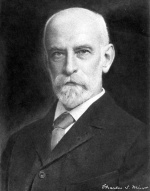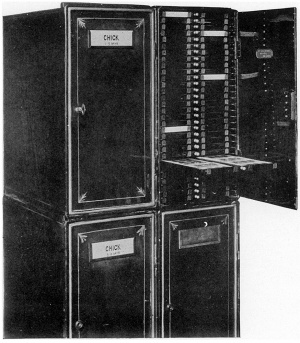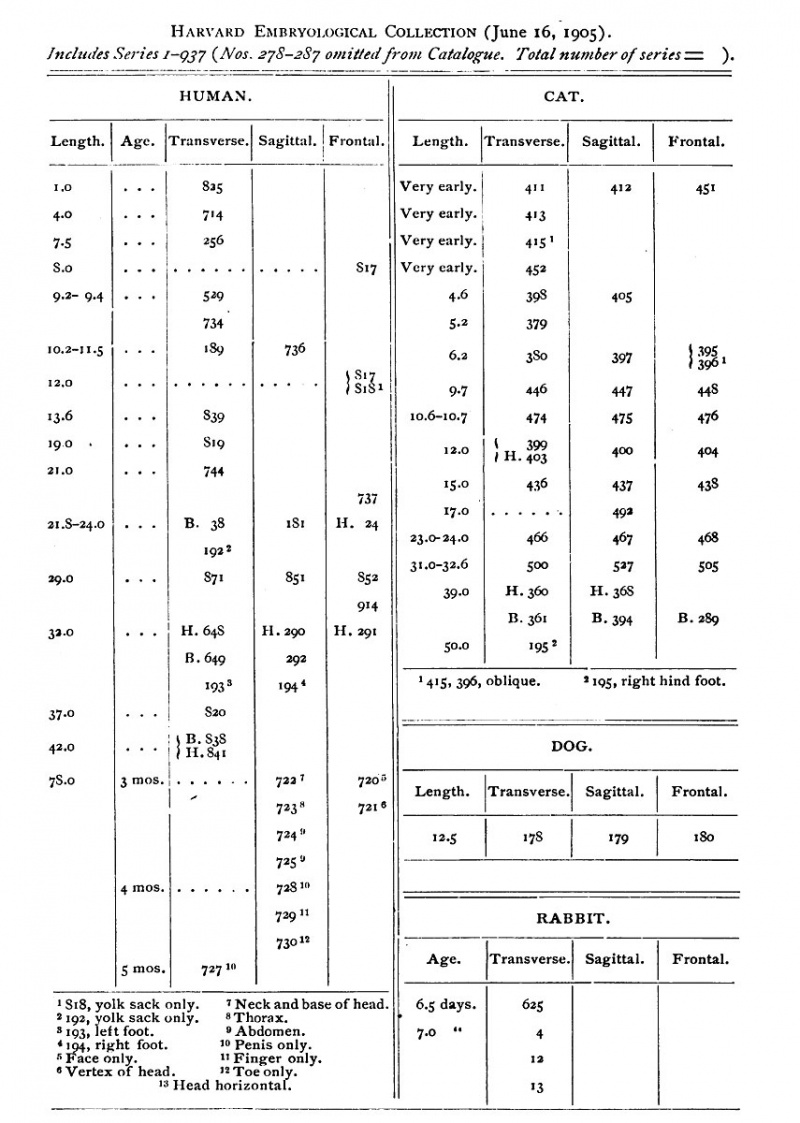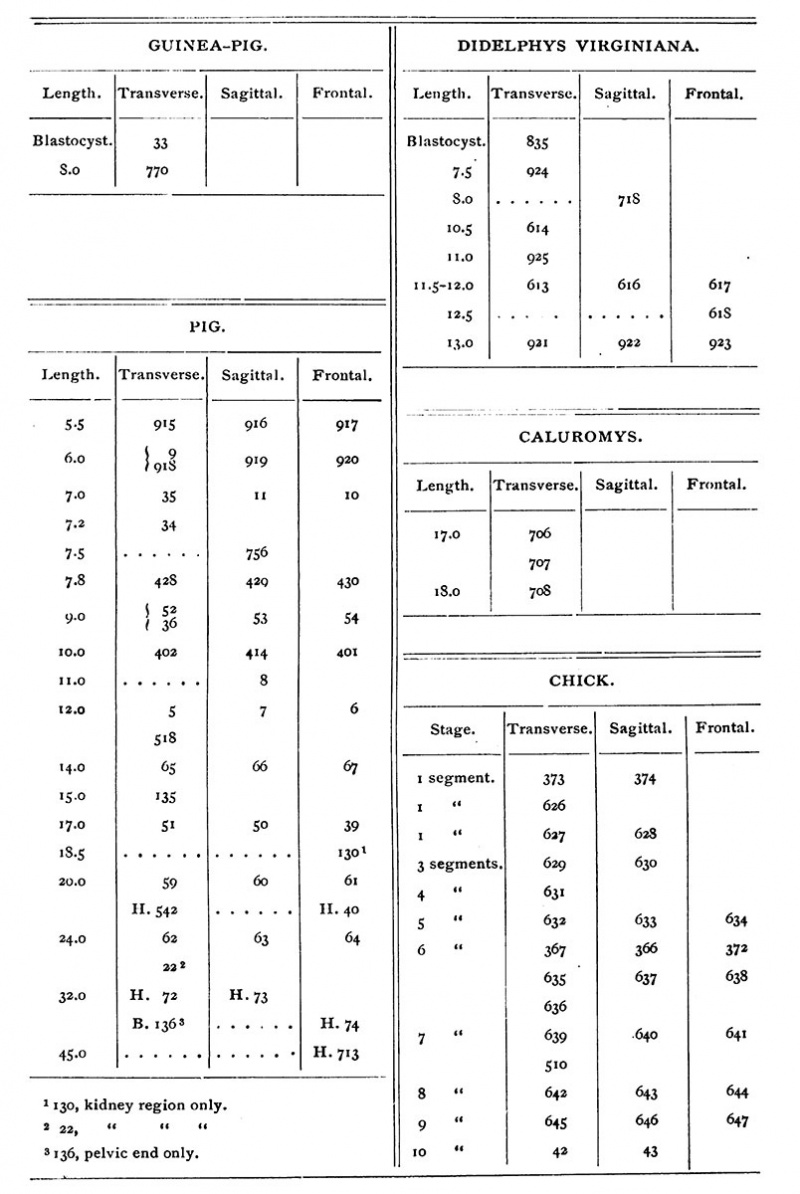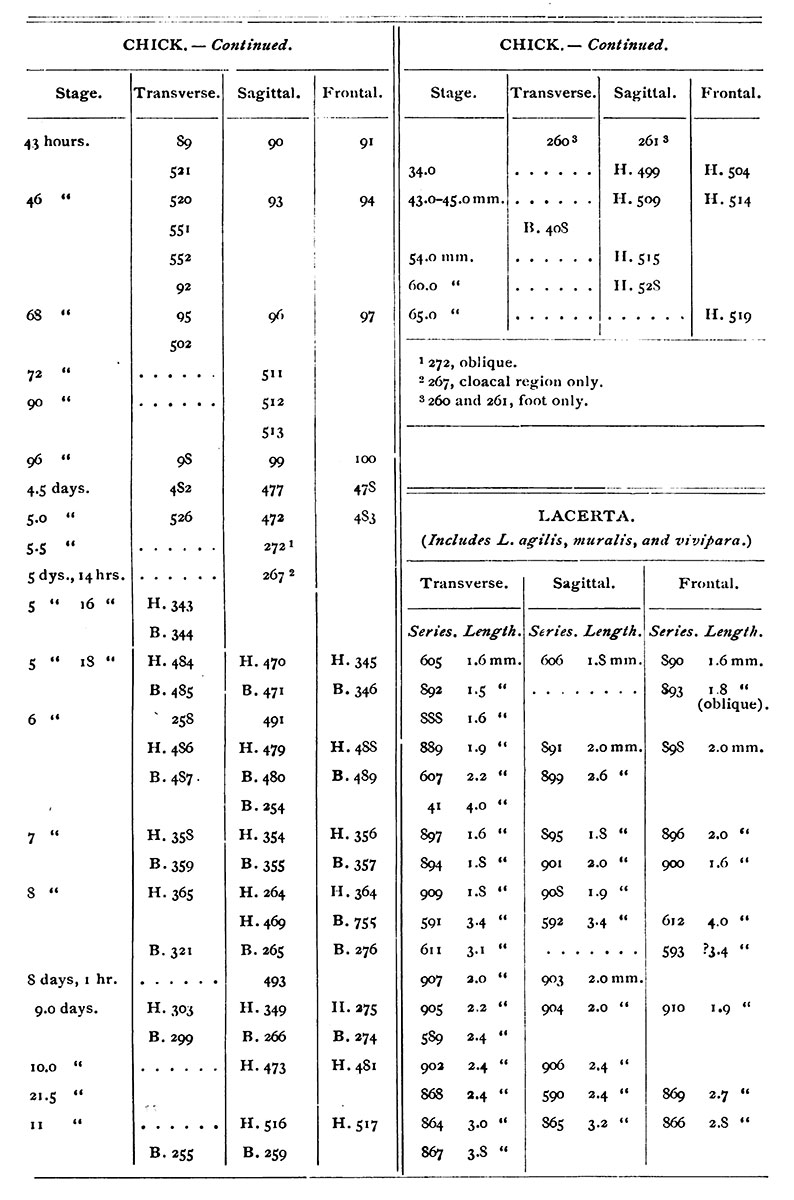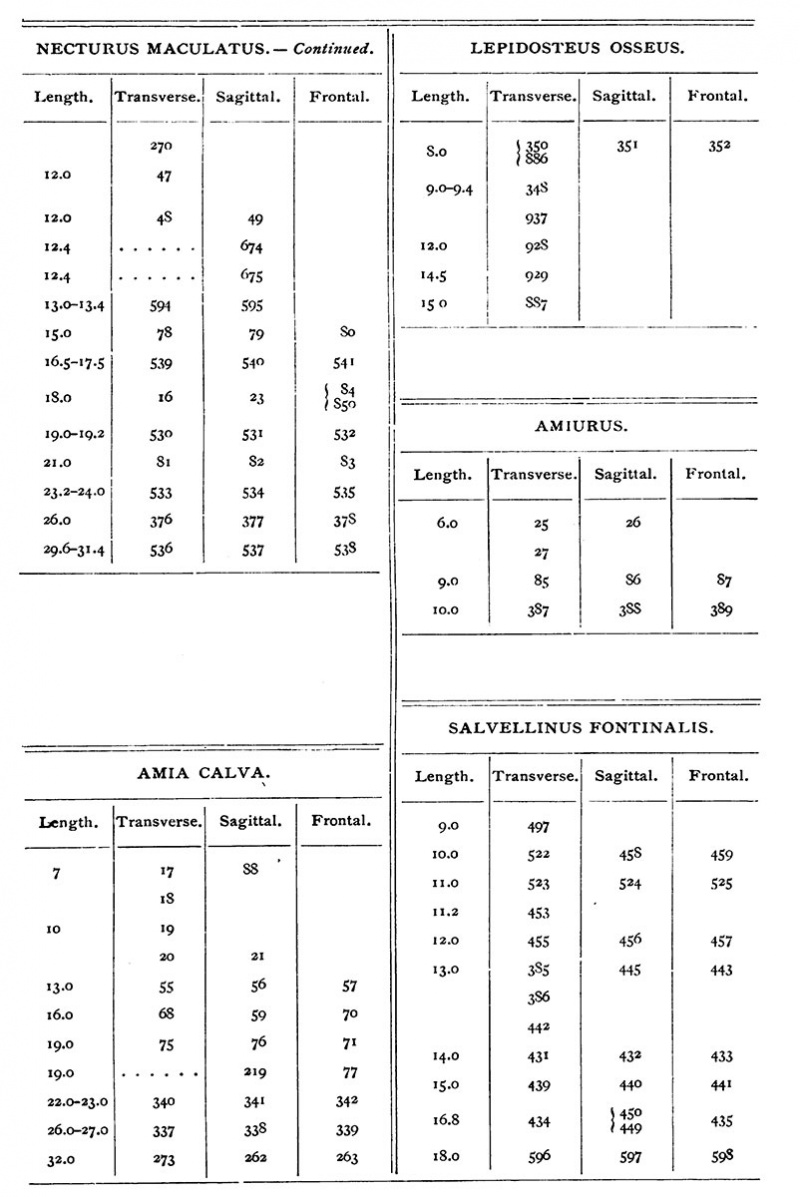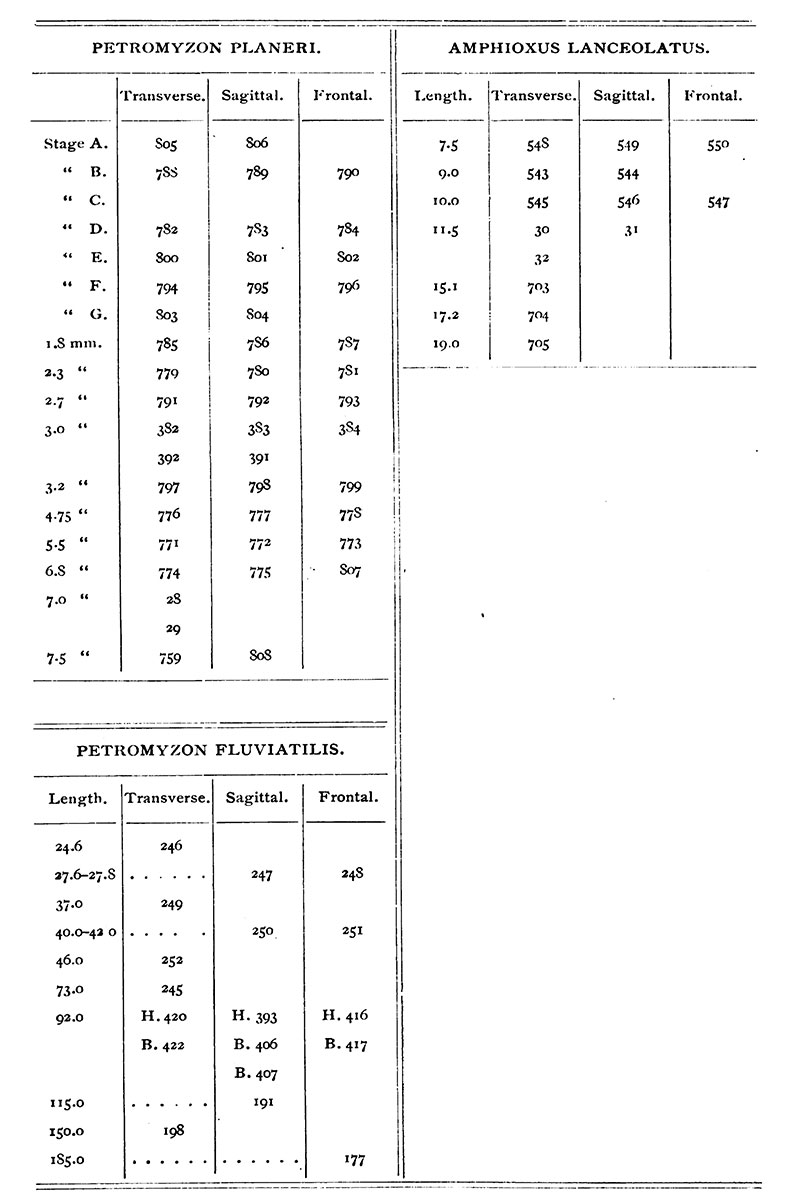Paper - The Harvard Embryological Collection (1905)
| Embryology - 20 Apr 2024 |
|---|
| Google Translate - select your language from the list shown below (this will open a new external page) |
|
العربية | català | 中文 | 中國傳統的 | français | Deutsche | עִברִית | हिंदी | bahasa Indonesia | italiano | 日本語 | 한국어 | မြန်မာ | Pilipino | Polskie | português | ਪੰਜਾਬੀ ਦੇ | Română | русский | Español | Swahili | Svensk | ไทย | Türkçe | اردو | ייִדיש | Tiếng Việt These external translations are automated and may not be accurate. (More? About Translations) |
Minot CS. The Harvard embryological collection. (1905) J Med Res. Aug;13(5):499-522.PMID 19971684 | PDF
| Historic Disclaimer - information about historic embryology pages |
|---|
| Pages where the terms "Historic" (textbooks, papers, people, recommendations) appear on this site, and sections within pages where this disclaimer appears, indicate that the content and scientific understanding are specific to the time of publication. This means that while some scientific descriptions are still accurate, the terminology and interpretation of the developmental mechanisms reflect the understanding at the time of original publication and those of the preceding periods, these terms, interpretations and recommendations may not reflect our current scientific understanding. (More? Embryology History | Historic Embryology Papers) |
The Harvard Embryological Collection
Charles Sedgwick Minot, LL.D., D.Sc.
Received for publication June 29, 1905.
The collection of serial sections of embryos in the Embryological Laboratory of the Medical School has now grown to sufficient size to render clear the scope of the collection, and to enable us to form some estimate of its usefulness in facilitating study and promoting research. At this date it comprises nine hundred and thirty-seven series. The plan which has been followed was drawn up in 1895, and its execution was begun in January, 1896, and since that time work on the enlargemeent of the collection has been unremitting, although, of course, many other duties had to receive attention in the laboratory; the preparation of serial sections being only one of the things to be attended to in the course of the regular work. Our means have not hitherto permitted us to employ assistance which should be devoted exclusively to the development of the collection. In spite of these difficulties, however, the actual achievement may, I think, be regarded as encouraging.
| Amniota | Anamnia |
|---|---|
| Man
sheep (not yet begun) Lacerta Chrysemis (not yet begun) Eutaenia (not yet begun) Squalus |
Rana
Amblystoma Necturus Lepidosteus Amia Ameiurus Salvellinus Batrachus Torpedo Petromyzon Amphioxus |
It should be mentioned that in addition to our regular types we have a few others represented by a few series which have been prepared in connection with special researches, Such supplemental forms are the dog, guinea-pig, Caluromys, Torpedo marmorata, Raja clavata, and Scyllium canicula. The number and variety of these series will doubtless increase hereafter.
The plan is, further, to obtain of each of these typical species a complete series of embryos, to select systematically graded stages, and of each stage, so far as possible, three identical embryos. The three specimens thus picked out are intended to be cut intoserial sections, one embryo transversely, the second sagittally, and the third frontally. Bythismeans views of the structures in the embryo, according to the three planes of space, can be obtained, and at the same time there is the advantage of some indication of the variations which occur from embryo to embryo in a given stage. In order to carry out this plan it has been indispensable to resist the frequently recurring temptation of cutting up a fine embryo, which did not fit into the scheme adopted, for this would delay indefinitely the completion of the plan. Series of sections, gotten up according to this scheme, may be regarded as normal series, illustrating the development of a particular type, and through that type the development of the class to which it belongs. The various forms selected can be compared with one another, and thus there is always on hand material for comparative investigation. It is evident that such a collection as this could not answer foral the requirements of research, but serves well to enable one to make a preliminary study of the development of any organ or tissue, to find out exactly at what stages changes may be occurring which it is desired to investigate more closely, and to give more or less information, as to the nature of those changes. In actual practice it has been found, and will surely continue to be found, necessary to make many special preparations for special purposes, or to follow out certain details of modification, which may not be well illustrated with the material in hand, or which can be better brought out by other methods of preservation and of staining than those used for the specimens in the collection. In spite of althese limitations, however, the collection has proved itself already of substantial use for purposes of embryological research. So far as I am aware, no other collection of this kind has yet been attempted. There are,ofcourse,inthe possession of various individuals, and in a few laboratories, collections of serial sections of embryos of considerable size and great value,but unless I am mistaken the Harvard collection is the only one which was planned to be perfectly systematic, and which has been actually built up on the system originally proposed. In practice the system has been slightly departed from in certain cases, where the material at hand rendered this indispensable. This is chiefly the case with the series of human embryos, now 42 in number, for obviously the embryos of the human species inust be taken as they are obtained, and cannot be selected as they are desired.
The collection is intended to become a sort of a cyclopedia of vertebrate embryology to which one can turn at any time and get the desired information as to the principal features of development of any structure whatsoever. Itis hoped, therefore, that the laboratory will be regarded as a useful central place to which persons may come who are seeking embryological information, or who desire for the completion of their original researches the use of a larger material than they could command by their owIn individual unaided efforts. In a collection so extensive as this has now become, there is abundance of material for many workers, and there is never likely to be any great clashing of interests in the use of the specimens. It is with pleasure that I note that several professors of other universities have already utilised the opportunities which we are able to place attheir disposal, and it is hoped that the number of these will increase from year to year. The most liberal policy in this regard is surely for the best interests of all, and best calculated to promote the higher interests of science.
It is evident that, as a rule, the collection must remain in the laboratory and be used there, for its usefulness for reference and study would be impaired if the specimens which are needed cannot be found at hand. To a limited extent, perhaps, the practice may be accepted of sending specimens to workers elsewhere, and this has been done, opossum material having been sent to Prof. C. F. W. McClure, of Princeton, and material for the study of the development of the human jaw sent to Prof. Edward Fawcett, of University College, Bristol,Eng. At the end of this article will be found a list of published researches which have been based chiefly, or in part, upon the collection. It is pleasant to note much generous assistance which has been given us, especially in the way of aid in getting the material. The laboratory has been specially indebted in this respect to Prof. S. H. Gage, of Cornell, for specimens of the lamprey; to Prof. R. G. Harrison, of Baltimore, for lizard embryos; to Professor McClure, of Princeton, for opossum material; to Prof. Anton Dohrn for a fine set of torpedo embryos; to Prof. A. C. Eycleshymer, of St. Louis University, for various material; to Prof. W. A. Locy, of Northwestern University, for necturus; to Prof. Karl Peter, of Breslau, for lacertas; to Professor Dendy for several sphenodons, and to several other generous friends. Our human embryos we have received chiefly from practitioners in Boston and the neighbourhood, to all of whom our most sincere thanks are due. Among these human embryos are some of the very finest, and scientifically most valuiable, which have been as yet obtained for scientifics tudy. Agift of two hundred dollars from Dr. Walter G. Chase enabled us to employ aid,which contributed very much to the growth of the collection.
It seems desirable to describe some of the technical methods used in the preparation and cataloguing of the series.
With regard to fixation of the specimens we have contented ourselves with employing the standard reagents. Of' these, the three which we have found most useful are Zenker's fluid, asaturated solution of corrosive sublimate, and ten percent formalin. Zenker's fluid has proved very satisfactory for the embryos of all the Amniota and for the young stages of Amphibia and freshwater fish. It cannot, however, be used with very large specimens, as it has no great penetrating power. It does not work satisfactorily with the embryos of saltwater fishes. For these we have found the saturated solution of corrosive preferable. Even better results are obtained, according to our experience, with the embryos of Elasmobranchs when five percent of glacial acetic acid is added to the corrosive. This aceto-corrosive mixture has been very satisfactory also with reptilian embryos. For larger specimens we consider ten percent formalin preferable to everything else which we have tried, and there sults of this reagent have far surpassed our expectations, for we have even observed fairly good karyokinetic figures in material preserved with it. It is the only reagent with which we have obtained even tolerable preservation of the more advanced stages of the opossum, although the early development of the epitrichium and horny layer in this species prevents the penetration of the ordinary preservatives except in very early stages. Formalin we use almost exclusively for human embryos. It is easy for a practitioner to obtain this mixture, or to make it when he secures a human embryo, and its use being so very simple, this reagent finds favour among physicians in general practice. Formalin specimens contract when transferred to alcohol, but this contraction may be largely reduced by putting the specimens in Muller's fluid for forty-eight hours before placing them in alcohol.
It seems not to be really necessary to wash the specimens which are preserved in Zenker's fluid. All of our embryos are transferred gradually to alcohols of increasing strength, but they are never put in alcohol of greater than eighty per cent until just before they are cut, when they are transferred to ninety-five per cent alcohol for twenty-four hours to harden them. I consider the use of stronger than eighty percent alcohol for permanent preservation of embryos very undesirable. In the case of older embryos it causes a shrinkage, and in the case of all embryos it is apt to make a true final hardening, for the purposes of embedding, difficult or even impossible.
For the storing of embryos a convenient method has proved to be the use of a combination of small vials and large jars. A single museum jar is used for one species only,and mislabelled accordingly. The embryos are sorted according to stages, methods of preservation, etc., in cylindrical vials, which have flat bottoms, so that they will stand upright, and straight sides (Fig. 1). The size we have used most measures sixty millimeters in height by twenty millimeters in diameter. Vials with mouths narrowed are excessively inconvenient. The vials are closed with plugs of absorbent cotton. When necessary a slip of paper, bearing memoranda concerning the specimens in a vial, is put in alongside the plug of cotton, by which it is held in place. The writing on the slip is turned towards the outside of the vial, so that it can be read without displacing it or disturbing the specimens. Data are written with a lead pencil, but when a more permanent record is desired it is better to use Higgins's waterproof ink. A dozen or more vials may be kept together in a single jar.
In regard to the selection of stages we have had, of course, in the case of each new form to proceed somewhat arbitrarily, but experience has shown that so soon as the embryo is sufficiently advanced for its length to be measured, one may say that an addition of one-fifth or one-sixth to the length corresponds to a sufficient advance in development for the embryo to be said to have passed into a new stage. Atthe same time such an increase in length does not bring about so great an alteration of structure as to render it difficult to trace the nature of the change which has gone on. Onthe other hand, it is occasionally necessary for some special study to have the stages closer than this, but the stages, arbitrarily fixed by the rule indicated, we have found by experience to be sufficiently close to one another to afford command of the whole course of development. Asstated above, we have endeavored to procure of each of these stages three specimens alike in length, but we have learned that it is also very desirable to get them as nearly as possible alike in form and external proportions. If this is done the internal development is usually very much the same in the three representatives of a given stage. If,ontheotherhand, we have three embryos, say of a pig, which are of the same length measured from the vertex to the tail, but differ from one another in external form, we shall find that they vary considerably in their internal organisation.
It is desirable to have a drawing or a photograph of every embryo which is sectioned. In practice we rely chiefly upon drawings, but we think photographs would be preferable, and we should have made them were it not that photography in our present cramped quarters is so inconvenient. When we move into our new laboratory we hope to substitute photography for the drawings upon which we depend at present.
Almost all of our specimens have been stained intoto before they were embedded, the stains upon which we have chiefly relied have been alum cochineal and borax carmine. At first we contented ourselves with a single stain, but we now habitually employ a counter stain as well, the three chief counter stains which we use being orange-G, Lyons blue, andeosine. We consider borax carmine and I Lyons blue a particularly useful combination. It sometimes happens that the cochineal or carmine stain is too faint,and insuchcases our practice has been to stain the sections on the slide with saffranine. Occasionally, but not often, we have stained a series with Haidenhain's iron hematoxyline, counter staining with orange-G.
It is important to have uniform rules for the making of sections so that they may be in similar orientation in all the series. To accomplish this our series have nearly all been cut according to the following directions:
Directions for Cutting Serial Sections of Embryos
Note. The lower edge of the ribbon is the one to the left, when the observer has the object between himself and the knife.
1. Transverse Series:
- Normal thickness 10 µm
- Dorsal surface to be towards the lower e(dge of the ribbon.
- Series to begin with the head.
- In cutting, the left sidle of the emlbryo must strike the knife first.
2. Sagittal Series:
- Normal thickness.
- Small embryos 10 µm
- Medium embryos. 15 µm
- Large embryos 20 µm.
- The head of the embryo to lie towards the lower edge of the ribbon.
- Series to begin with the right side.
- In cutting, the ventral si(le of the embryo imiust strike the knife first.
3. Frontal Sections:
Normal thickness.
- Small embryos 10 µm
- Medium embryos. 15 µm
- Large embryos 20 µm
- The head of the embryo is to be towards the lower edge of the ribbon.
- The series is to begin with the ventral side.
- In cutting, the left side of the einbryo must strike the knife first.
Mounting:
Leave space for the label at the lefthand end of the slide. Keep the sections in the order cut. Arrange them on the slides in the sequence of ordinary written lines. Care must be taken to make the rows of sections as straight as possible.
All of our series are mounted on slides, forty by seventy-six millimeters, and we now insist upon the slides being from I.8 to 2 millimetres thick. The thin slides, which have so long been favorites, are very fragile and often get broken. The thicker slides are much less subject to accident, and have no disadvantages, so far as I know, except that of not permitting the use ofa very short focussed condenser with the microscope. This disadvantage seems to be more theoretical than real. The size of slide adopted was chosen after considerable deliberation, and seems to me, on the whole, to be the most convenient for such series as we have gathered. On this slide we use a standard size of cover-glass, one measuring thirty-five by fifty millimeters. The sections are mounted so as to leave one end free for the label, which is placed as shown in the accompanying figure (Fig.2). On this label the name of the species, direction, and thickness of the sections and their staining are recorded. The label also carries the number of the series and a letter to indicate the position of the slide in the series. This is merely for facilitating the quick arrangement of the slides in cabinets. And finally,the label indicates the numbers ofthe sections, there being recorded for each row of the sections the number of the first and of the last section in that row. This makes it very easy to determine quickly by counting from either end of the row the exact number of any section in the series. In order to have permanent labels we use for writing either Stevens's blue-black writing fluid or Higgins's waterproof ink. I prefer the former.
When researches are published, in which any figures are given, taken from any of our sections, we require that the number of the series and the number of the section should be given, together with the figure. In this way the original evidence of the author's observation can be quickly found, and his statements easily verified. In consequence of this rule the collection is becoming more and more comparable to a collection of types, such as systematic zoologists value so highly. It is to be hoped that this practice will extend to other laboratories, so that the custom may become general of preserving, in each institution, in a readily accessible form, the material which has served as the basis for researches, thus rendering permanently possible the after verification of the actual observations. Certainly no investigator will work less accurately because he knows that his specimens may be restudied by his successors in order to test the reliability of his observations.
In regard to the cataloguing it is only to be remarked that we have of course a double catalogue. First,abookin which each series is entered in numerical order. Foreach series the following data are entered: the species, size, age, locality, drawing, nature of the sections, date of preservation, date of sectioning, method of preservation, staining, mounting. There is also column for special remarks. Second, there isa card catalogue inwhich the series are grouped first, according to species; second, according to the stage; and third, for each stage according to the plane of section, the order being always for each stage, transverse series first, sagittal second, frontal third. The arrangement of the series in the cabinets agrees with the card catalogue, following precisely the same order, so that by consulting the card catalogue it may be seen at once precisely what material we have of any given animal, and the position of the card indi- cates also the position of the series in the cabinet.
In regard to the storing of the series a few words may be added. We have tried both the small wooden slideboxes, and also the pasteboard trays, which are stacked together and kept in boxes, the latter of the type so much used in Germany, but neither of these have we found convenient. For several years we relied upon wooden cabinets with small trays, which could be pulled in and out, but these cabinets even when they are made with great care are not wholly satisfactory, because no method has yet been devised of making the trays simplyand cheaply, yet in a formin"which they will not warp. By far the best trays, however, which we have succeeded in getting are those which are made of California red wood. Theseholdvery well, and change their shape so slightly that they go out and in their places quite smoothly, which is more than we can say of trays made of any other vood which we have tried. But there is another objection also to wooden cabinets- the danger from fire. If a fire should once start in them, it might easily destroy the entire collection. Another objection to wooden cabinets is that the wood forms a cloudy deposition the surface of the glass slides. If the preparations are left for several months it becomes necessary to clean off the slides and cover-glasses to render them fit for microscopic examination. These considerations have led us toadopt a metal cabinet,which has been specially devised for our needs. It is made of sheet tin in such a manner that the trays are very compact, are absolutely interchangable, and take-up a minimum amount of room. The construction adopted is such that the tendency to warp is entirely done away with (Fig.3) The trays are all japanned so that they do not rust, and we slip a bit of white paper into each tray to make a background for the sections. Each tray is, moreover, furnished with a litle label holder, and they are put together in cabinets of thirty trays each, the trays themselves being of such a size that they will hold twenty-four of the ordinary slides, three inches by one. Moreover, the cabinets themselves are so devised that they can be stacked one on top of another, taking up a minimum amount of room. We devote a vertical column of these cabinets to a species, and simply interpolate from time to time a new cabinet in the column as the growth of the collection may render necessary. The cabinets are made by Peter Gray & Co., of Union street, Boston, and are now kept in stock by several of the dealers in microscopical supplies in this country. They cost only a trifle more than the wooden cabinets, and are, according to our trial of them, certainly to be preferred to any other form of cabinet which we have tested.
The account of the Harvard Embryological Collection would be incomplete without a word of appreciative acknowledgment of the zealous aid given by the members of the laboratory staff. This is especially due Dr.Alfred Schaper, now professor at Breslau, who co6perated very extensively in the foundation and early development of the collection, and to three of our present members, Drs. J. L. Bremer, F. T. Lewis, and E.Taylor. All of these gentlemen have used the collection for important investigations which they have made.
The following tables show the present extent of our collection. They are so arranged as to be self-explanatory. For each species there are four columns. The first gives the length or age. The second is for the transverse series,the third for the sagittal,the fourth for the frontal series. The numbers are the numbers of the series. Thus, in the first table of human embryos, the second specimen is an embryo of four millimetres in length. It was cut into transverse sections, and the series was entered as Number 714. Itwillbe noticed that the most nearly complete set of series which we have is of Torpedo ocellata. With very few exceptions all our series up to the present are of embryos not of the earlier stages, which itis hoped will be added later.
Certain of our human embryos deserve special mention.
The youngest specimen we have furnished Series 825. The embryo is in a good state of preservation and is in the stage just before the formation of the medullary plate. The chorionic vesicle was received intact,and measured without the vili 7 by 8 by 11.5 millimeters. A description of this embryo for publication has been undertaken by Dr. F. T. Lewis. It is the youngest stage which I personally have ever had the opportunity of examining, and it belongs among the half dozen youngest human embryos known.
A fine embryo of four millimetres has furnished Series 817. It was preserved in formalin and exhibits good karyokinetic figures. So far as the condition of the embryo itself indicates, the specimen is normal, but it differs in many respects from the few human embryos of this size which have been hitherto described. The anterior neuropore is wide open, and the caudal end of the spinal cord is stil in the stage of the medullary plate. It shows very striking peculiarities, by which it differs from the other human embryos of this size which have heretofore been studied. The question arises whether this embryo is really not more normal thantheothers. It will form the subject of a monograph by Dr.J.L Bremer. He has just completed wax plate reconstructions of all the more important parts.
The following five embryos are al normal specimens in first-class condition, which have yielded exceptionally fine series:
| Embryo of | Series |
|---|---|
| 8 mm. | 817 |
| 12 | 816 |
| 13.6 | 839 |
| 23 | 181 |
| 22.8 | 737 |
The two embryos last mentioned represent the stage at the end of about two months. Series 181 consists of sagittal sections and Series 737 of frontal sections. The brain of this last is being investigated by Dr. Ewing Taylor. It is one of the finest embryonic mammalian brains which I have ever seen, so far as the perfection of its preservation goes and the clearness with which the various parts have been differentiated by the stain, in this case borax carmine and Lyon's blue.
Another embryo also good, but not quite in perfect condition, measured 10.2 millimetres, and now exists in sagittal sections as Series 736.
Catalogue Table
Human
|
|
Human, Cat, Dog and Rabbit
Rabbit
Guinea Pig, Pig and Chicken
Chicken and Lizard
Lizard
Garfish, Catfish and Trout
Catfish and Torpedo
Spiny dogfish and Thornback ray
Lamprey and Lancelet
Plate
VOL. XIII. PLATE XXXIX. (3 figures)
| Fig. 1. | Fig. 2. |
|---|---|
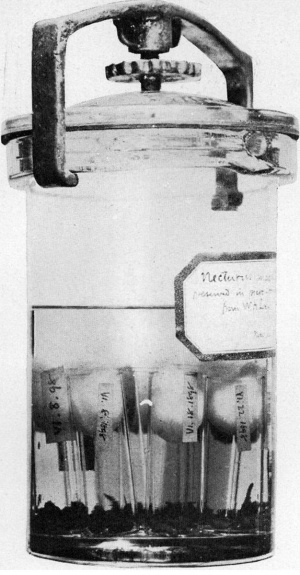
|
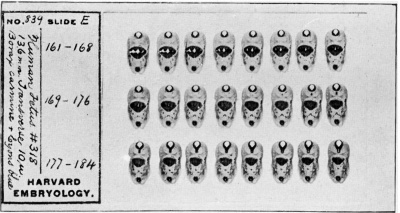
|
| Fig. 3. | |

|
List Of Published Researches
(Based wholly or in part on material in the Harvard Emnbryological Collection.)
1895. F. Dexter. Ein Beitragzur Morphologie des verlängerten Markes beim Kaninchen. Arch. Anat. Entwickelungsges, 1895, 423-437.
1896. C.S. Minot. The original type of vertebrate development. Procs British Assoc. Adv. Sci., I896.
1897. A. Schaper. D)iefriuhesten I)ifferenzirungsvorghnge im Central] nervensystem und die Entwickelung der Neuroblasten und Sponigioblasten. Archiv. fuirEntwickelungsmechamk, v,31- 132.
I898. C.S. Minot. Cephalic homologies. Amer. Nat., xXXi, 927-943; also translated in Arch Zool.Expt.,Ser.i,Tomev,417-436. On the veins of the Wolffian body in the pig. Proc. Boston Soc.Nat Hist., xxviii, 265-274.
- A. Schaper. The finer structure of the selachian cerebellum. Journ. Comp. Neurol.,vi,1-20.
1899. A. Schaper. Zur Morphologie des Kleinhirns. Verhandl.Anat. Ges. Tiubigen,xi,I02-115.
- Zur Histologie des Kleinhirns der Petromyzonten Anat. Anz., xvi, 439-446.
- F. Dexter. Uber die Mlorphologie des Verdaunngssystembeider Katze. Arch. Anat. Entwickelungsges,1899,I59-I92.
1900. C.S. Minot. On a hitherto unrecognised form of blood circulation without capillaries in the organs of vertebrates. Proc. Boston S.N. I.,xix,I85-215.
- On the solid stage of the large intestine in the chick. Journ. Boston Soc.Med Sci.,iv, IS3-I64.
- Ueber mesotheliale Zotten der Allantois bei Schweinsem- bryonen. Anat.Anz.,xviii,127-136.
- F. Dexter. Additional observations on the morphology of the digestive tract of the cat. Journ.Boston Soc.Med.Sci.,iv,205- 212.
Minot CS. The embryological basis of pathology. (1901) Science 13(326);481-98. PMID 17791097 also Boston Med. Surg. Journ., clxiv, 295-305.
- R.T. Atkinson. The early development of the circulation int he suprarenal of the rabbit. Anat.Anz.,xix, 610.
1902. C. S. Minot. On the morphology of the pineal region. Amer. Journ. of Anatomy, i, 81-98.
- F.A. Woods. Origin and migration of the germ cells in Acanthias. Amer. Journ. Anat.,i,307-320.
- J.I,. Bremer. On the origin of the pulmonary arteries in mammals. Amer. Journ. of Anat., 1, 137-144.
- A.C. Eycleshymer. Nuclear changes in the striated muscle cell of necturus. Anat. Anzx, xxi,379-385.
Lewis FT. The development of the vena cava inferior. (1902) Amer. J Anat. 1(3): 229-244.
- F. Dexter. The development of the paraphysis in the common fowl. Amer. Journ. Anat., 1, 13-24
- On the vitelline vein of the cat. Amer. Journ. Anat, 1 ,26t- 267-
Minot CS. A Laboratory Text-Book Of Embryology. (1903) Philadelphia:P. Blakiston's Son & Co.
- J.L. Bremner. Development of the lung in the opossum. Amer. Journ. Anat., i, 67-73.
- F.T.Lewis. The gross anatomy of a twelve millimeter pig embryo. Amer.Journ.Anat., 1, 211-226.
- A. C. Eycleshymer. Notes on the histogenesis of the striated muscle in necturus. Amer.Journ. of Anat.,i,pp.xiv-xv.
1904. A.C. Eycleshymer. The cytoplastmiic and nuclear changes in the striated muscle cell of necturus. Amer. Journi .Anat., 1, 285-310.
- F.T. Lewis. The question of sinusoids. Anat. Ariz., xxv, 261-279.
1905. C.S. Minot. Genetic interpretations in the domain of anatomy. Amer. Journ. Anat., iv, 243-263.
- C.S. Minot. The implantation of the human ovum in the uterus. Trans. Amer. Gynecol. Soc., 1904, 39s-402.
- W. A. Locy. On a newly recognized nerve connected with the fore-braininselachians. Anat. Anzeiger, xxvi, 33-63 ,I 111-123.
Researches In Progress
Minot CS. and Taylor E. Normal Plates of the Development of the Rabbit Embryo (Lepus cuniculus). Vol. 5 in series by Keibel F. Normal plates of the development of vertebrates (Normentafeln zur Entwicklungsgeschichte der Wirbelthiere) Fisher, Jena., Germany.
Minot CS. Uterus And Embryo - I. Rabbit II. Man. (1889) J Morphol. 2:
C. S. Minot. Early development of the human chorion and decidua.
F.T. Lewis. Development of the lymphatics in mammals.
Lewis FT. On the cervical veins and lymphatics in four human embryos, with an interpretation of anomalies on the subclavian and jugular veins in the adult. (1909)
- Description of a very early human embryo.
Bremer JL. Description of a 4-mm human embryo. (1906) Amer. J Anat. 5: 459-480.
E.Taylor. Structure of the human brain in the two months' embryo.
C.F.W. McClure. Development of the veins in the opossum. (Intarton our material.)
Edw. Fawcett. Development of the facial bones in man. (In part on our material.)
John Warren. Development of the pineal region in necturus.
| Historic Disclaimer - information about historic embryology pages |
|---|
| Pages where the terms "Historic" (textbooks, papers, people, recommendations) appear on this site, and sections within pages where this disclaimer appears, indicate that the content and scientific understanding are specific to the time of publication. This means that while some scientific descriptions are still accurate, the terminology and interpretation of the developmental mechanisms reflect the understanding at the time of original publication and those of the preceding periods, these terms, interpretations and recommendations may not reflect our current scientific understanding. (More? Embryology History | Historic Embryology Papers) |
Reference
Minot CS. The Harvard embryological collection. (1905) J Med Res. Aug;13(5):499-522.PMID 19971684 | PDF
Cite this page: Hill, M.A. (2024, April 20) Embryology Paper - The Harvard Embryological Collection (1905). Retrieved from https://embryology.med.unsw.edu.au/embryology/index.php/Paper_-_The_Harvard_Embryological_Collection_(1905)
- © Dr Mark Hill 2024, UNSW Embryology ISBN: 978 0 7334 2609 4 - UNSW CRICOS Provider Code No. 00098G

